
Hydraenidae is a family of very small aquatic beetles, sometimes called "Minute moss beetles", with a worldwide distribution. They are around 0.8 to 3.3 mm in length. The adults store air on the underside of the body as well as beneath the elytra which allows them to crawl underwater, often on the underside of the water surface tension, though they cannot swim. Some species have gills that effectively allow them to stay underwater indefinitely. Larvae vary from being fully terrestrial, to being aquatic at least in their earliest instars. The diet of hydraenid larvae and adults is thought to consist of algae, spores and other plant matter. At least some hydraenid adults use stridulation to communicate. There are around 1,300 species in 42 genera.

The Neriidae are a family of true flies (Diptera) closely related to the Micropezidae. Some species are known as cactus flies, while others have been called banana stalk flies and the family was earlier treated as subfamily of the Micropezidae which are often called stilt-legged flies. Neriids differ from micropezids in having no significant reduction of the fore legs. Neriids breed in rotting vegetation, such as decaying tree bark or rotting fruit. About 100 species are placed in 19 genera. Neriidae are found mainly in tropical regions, but two North American genera occur, each with one species, and one species of Telostylinus occurs in temperate regions of eastern Australia.

Harpalus is a genus of ground beetle first described by Pierre André Latreille in 1802.
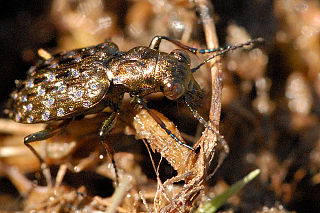
Elaphrus is a genus of ground beetle native to the Palearctic, the Nearctic, the Near East and Northern Africa. It contains the following species:
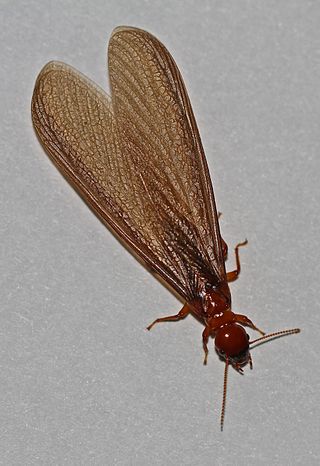
Zootermopsis angusticollis is a species of termite (Isoptera) in the family Archotermopsidae, a group known as the dampwood termites, or the rottenwood termites. As their name suggests, the dampwood termites can only survive by living off of wood that contains high amounts of moisture. They are found along the wet environments of the Pacific coast of North America. Most are found in the states of California, Oregon, Washington, Idaho, Western Nevada and in southern British Columbia. Termites are well known to be destroyers of wood, and although the dampwood termites can cause some damage, they are not as notoriously known to cause as much damage to buildings as the drywood termites. They occasionally have been carried to other parts of the country through wood shipments, but have not been able to become established in these areas due to undesirable environmental conditions.
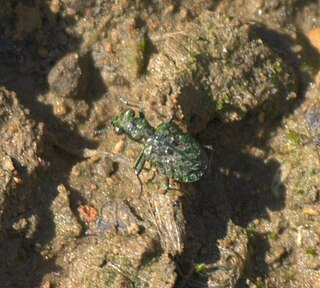
Elaphrinae is a subfamily of ground beetles in the family Carabidae. There are at least 4 genera and more than 50 described species in Elaphrinae.
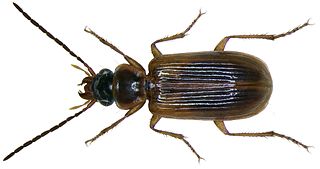
Anthracus is a genus of beetles in the family Carabidae, containing the following species:
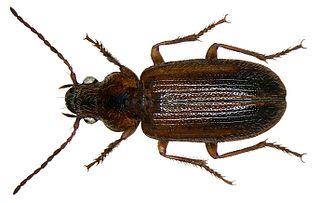
Dicheirotrichus is a genus of beetles in the family Carabidae, containing the following species:
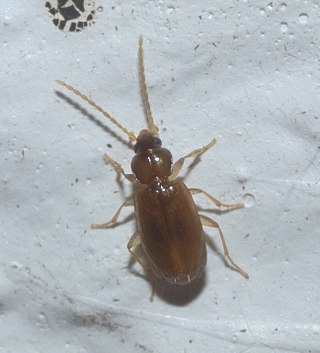
Micratopus is a genus of ground beetles in the family Carabidae. There are about five described species in Micratopus.
Nebria frigida is a species of ground beetle in the Nebriinae subfamily that is native to the Palearctic realm and Russia. There, it is found in cities such as Altai, Chita, Kamchatka, Khabarovsk, the Ural Mountains, Krasnoyarsk, Magadan, north of western Siberia, and into Yakutiya. It is also common in the US state of Alaska.
Elaphrus punctatus is a species of ground beetle in the subfamily Elaphrinae. It was described by Victor Motschulsky in 1844.
Elaphrus sibiricus is a species of ground beetle in the subfamily Elaphrinae. It was described by Victor Motschulsky in 1844.
Tanymecini is a tribe of broad-nosed weevils in the beetle family Curculionidae, subfamily Entiminae.
Reinhold Ferdinand Sahlberg was a Finnish naturalist notably specialising in entomology.

Peritrechus is a genus of dirt-colored seed bugs in the family Rhyparochromidae. There are at least 20 described species in Peritrechus.
Dicheirotrichus mannerheimii is a species of ground beetle in the family Carabidae. It is found in Europe and Northern Asia and North America.

Caenoscelis is a genus of silken fungus beetles in the family Cryptophagidae. There are about 19 described species in Caenoscelis.
Derocephalus angusticollis is a fly in the family Neriidae. They are typically found on the east coast of Australia near rotting vegetation. Aggregating on the rotting bark of trees such as Acacia longifolia and other trees in New South Wales and southern Queensland. D. angusticollis flies found in the wild have accelerated speeds of development and age of mortality when compared to those in captivity. Derocephalus One characteristic of the neriid fly is that it demonstrates sexual dimorphism. Males have a larger build as well as exaggerated physical characteristics such as wider heads and longer limbs. Certain phenotypic characteristics are dependent on the diet of the parents.











